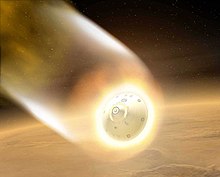Our website is made possible by displaying online advertisements to our visitors.
Please consider supporting us by disabling your ad blocker.
Atmospheric entry

Atmospheric entry (sometimes listed as Vimpact or Ventry) is the movement of an object from outer space into and through the gases of an atmosphere of a planet, dwarf planet, or natural satellite. Atmospheric entry may be uncontrolled entry, as in the entry of astronomical objects, space debris, or bolides. It may be controlled entry (or reentry) of a spacecraft that can be navigated or follow a predetermined course. Methods for controlled atmospheric entry, descent, and landing of spacecraft are collectively termed as EDL.
Objects entering an atmosphere experience atmospheric drag, which puts mechanical stress on the object, and aerodynamic heating—caused mostly by compression of the air in front of the object, but also by drag. These forces can cause loss of mass (ablation) or even complete disintegration of smaller objects, and objects with lower compressive strength can explode.
Objects have reentered with speeds ranging from 7.8 km/s for low Earth orbit to around 12.5 km/s for the Stardust probe.[1] They have high kinetic energies, and atmospheric dissipation is the only way of expending this, as it is highly impractical to use retrorockets for the entire reentry procedure. Crewed space vehicles must be slowed to subsonic speeds before parachutes or air brakes may be deployed.
Ballistic warheads and expendable vehicles do not require slowing at reentry, and in fact, are made streamlined so as to maintain their speed. Furthermore, slow-speed returns to Earth from near-space such as high-altitude parachute jumps from balloons do not require heat shielding because the gravitational acceleration of an object starting at relative rest from within the atmosphere itself (or not far above it) cannot create enough velocity to cause significant atmospheric heating.
For Earth, atmospheric entry occurs by convention at the Kármán line at an altitude of 100 km (62 miles; 54 nautical miles) above the surface, while at Venus atmospheric entry occurs at 250 km (160 mi; 130 nmi) and at Mars atmospheric entry at about 80 km (50 mi; 43 nmi). Uncontrolled objects reach high velocities while accelerating through space toward the Earth under the influence of Earth's gravity, and are slowed by friction upon encountering Earth's atmosphere. Meteors are also often travelling quite fast relative to the Earth simply because their own orbital path is different from that of the Earth before they encounter Earth's gravity well. Most objects enter at hypersonic speeds due to their sub-orbital (e.g., intercontinental ballistic missile reentry vehicles), orbital (e.g., the Soyuz), or unbounded (e.g., meteors) trajectories. Various advanced technologies have been developed to enable atmospheric reentry and flight at extreme velocities. An alternative method of controlled atmospheric entry is buoyancy[2] which is suitable for planetary entry where thick atmospheres, strong gravity, or both factors complicate high-velocity hyperbolic entry, such as the atmospheres of Venus, Titan and the giant planets.[3]
- ^ Cite error: The named reference
stardustwas invoked but never defined (see the help page). - ^ "ATO: Airship To Orbit" (PDF). JP Aerospace. Archived (PDF) from the original on October 13, 2013. Retrieved December 14, 2013.
- ^ Gross, F. (1965). "Buoyant Probes into the Venus Atmosphere". Unmanned Spacecraft Meeting 1965. American Institute of Aeronautics and Astronautics. doi:10.2514/6.1965-1407.
Previous Page Next Page


